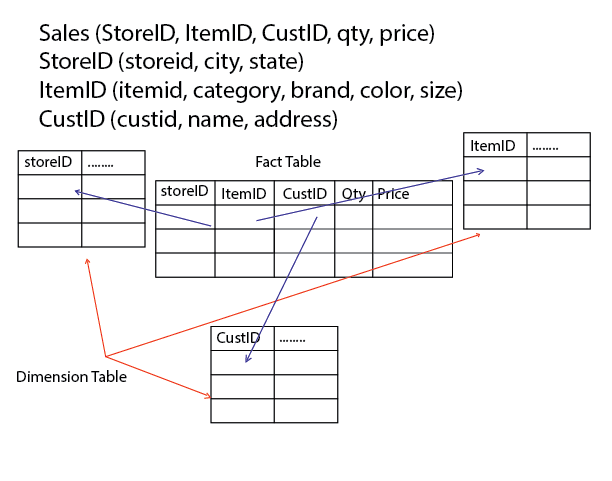What is Dimensional Modeling?Dimensional modeling represents data with a cube operation, making more suitable logical data representation with OLAP data management. The perception of Dimensional Modeling was developed by Ralph Kimball and is consist of "fact" and "dimension" tables. In dimensional modeling, the transaction record is divided into either "facts," which are frequently numerical transaction data, or "dimensions," which are the reference information that gives context to the facts. For example, a sale transaction can be damage into facts such as the number of products ordered and the price paid for the products, and into dimensions such as order date, user name, product number, order ship-to, and bill-to locations, and salesman responsible for receiving the order. Objectives of Dimensional ModelingThe purposes of dimensional modeling are:
Advantages of Dimensional ModelingFollowing are the benefits of dimensional modeling are: Dimensional modeling is simple: Dimensional modeling methods make it possible for warehouse designers to create database schemas that business customers can easily hold and comprehend. There is no need for vast training on how to read diagrams, and there is no complicated relationship between different data elements. Dimensional modeling promotes data quality: The star schema enable warehouse administrators to enforce referential integrity checks on the data warehouse. Since the fact information key is a concatenation of the essentials of its associated dimensions, a factual record is actively loaded if the corresponding dimensions records are duly described and also exist in the database. By enforcing foreign key constraints as a form of referential integrity check, data warehouse DBAs add a line of defense against corrupted warehouses data. Performance optimization is possible through aggregates: As the size of the data warehouse increases, performance optimization develops into a pressing concern. Customers who have to wait for hours to get a response to a query will quickly become discouraged with the warehouses. Aggregates are one of the easiest methods by which query performance can be optimized. Disadvantages of Dimensional Modeling
Elements of Dimensional ModelingFactIt is a collection of associated data items, consisting of measures and context data. It typically represents business items or business transactions. DimensionsIt is a collection of data which describe one business dimension. Dimensions decide the contextual background for the facts, and they are the framework over which OLAP is performed. MeasureIt is a numeric attribute of a fact, representing the performance or behavior of the business relative to the dimensions. Considering the relational context, there are two basic models which are used in dimensional modeling:
The star model is the underlying structure for a dimensional model. It has one broad central table (fact table) and a set of smaller tables (dimensions) arranged in a radial design around the primary table. The snowflake model is the conclusion of decomposing one or more of the dimensions. Fact TableFact tables are used to data facts or measures in the business. Facts are the numeric data elements that are of interest to the company. Characteristics of the Fact table The fact table includes numerical values of what we measure. For example, a fact value of 20 might means that 20 widgets have been sold. Each fact table includes the keys to associated dimension tables. These are known as foreign keys in the fact table. Fact tables typically include a small number of columns. When it is compared to dimension tables, fact tables have a large number of rows. Dimension TableDimension tables establish the context of the facts. Dimensional tables store fields that describe the facts. Characteristics of the Dimension table Dimension tables contain the details about the facts. That, as an example, enables the business analysts to understand the data and their reports better. The dimension tables include descriptive data about the numerical values in the fact table. That is, they contain the attributes of the facts. For example, the dimension tables for a marketing analysis function might include attributes such as time, marketing region, and product type. Since the record in a dimension table is denormalized, it usually has a large number of columns. The dimension tables include significantly fewer rows of information than the fact table. The attributes in a dimension table are used as row and column headings in a document or query results display. Example: A city and state can view a store summary in a fact table. Item summary can be viewed by brand, color, etc. Customer information can be viewed by name and address. 
Fact Table
In this example, Customer ID column in the facts table is the foreign keys that join with the dimension table. By following the links, we can see that row 2 of the fact table records the fact that customer 3, Gaurav, bought two items on day 8. Dimension Tables
HierarchyA hierarchy is a directed tree whose nodes are dimensional attributes and whose arcs model many to one association between dimensional attributes team. It contains a dimension, positioned at the tree's root, and all of the dimensional attributes that define it.
Next TopicWhat is Multi-Dimensional Data Model?
|
 For Videos Join Our Youtube Channel: Join Now
For Videos Join Our Youtube Channel: Join Now
Feedback
- Send your Feedback to [email protected]
Help Others, Please Share










